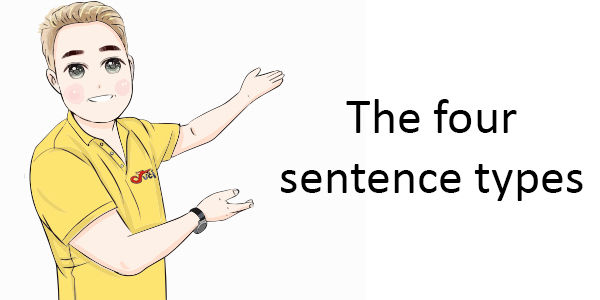
You must understand the basic sentence types for both the Writing and Speaking tests when preparing for the IELTS exam. In order to obtain higher level scores Grammatical Range and Accuracy are essential, as is the ability to use ‘complex’ sentences.
Below is a basic description of the different types of sentence structure used in English and some examples. It is not designed to be a complete and detailed explanation; read some grammar books for that, but hopefully, this will help you understand and use the basics.
Sentence construction
Subject and Predicate
Subject
A subject can be a noun or pronoun that is partnered with an action verb.
The simple definition of a noun is the name of: a person, place, or thing. Pronouns are substitutes for nouns.
Predicate
A predicate is a verb that expresses the subject’s action or state of being.
The four basic kinds of sentences
Simple Sentence
In English, the most basic sentence will have both a Subject and a Verb and will express a complete thought. Often, you can add other elements to a sentence in order to provide more detail. For instance, you might add adjecives, adverbs, or different phrases. The first sentence below is a ‘very’ Simple sentence that only contains a Subject and a Verb. The others have different elements added to this core structure.
- The boy runs.
- The boy runs for the bus.
- The boy runs slowly.
- The thin boy runs.
- Not wanting to be late, the boy runs for the bus.
Even though different phrases or modifiers have been included, you still have the core sentence of “The boy runs”.
When you have a Subject and a Verb that can stand alone as a complete idea/thought, this is called an Independent Clause. A clause is just a group of words that has a Subject and a Verb. Independent means that the clause has the ability to stand alone i.e. a complete sentence.
Compound Sentences
A Compound sentence consists of two or more independent clauses, or Simple Sentences, joined by co-ordinating conjunctions:
for, and, nor, but, or, yet, so
to name a few.
An example compound sentence is below.
Simple 1
Austria is a beautiful country.
Simple 2
Austria has many poor people.
Compound
Austria is a beautiful country, but has many poor people.
An easy way to tell if you have a compound sentence is to cross out the conjunction(known as a connective in IELTS) and see if you have a complete idea/thought on both sides. For example:
James went to work, and Michaela looked after the baby.
If you were to cross out the “and” you would have, in effect, two sentences – James went to work. Michaela looked after the baby. The sentence above then, is a compound sentence.
A compound sentence then, will consist of two, or maybe more, independent clauses.
Complex Sentences
The third kind of sentence structure is the Complex Sentence. This kind of sentence is made up of an independaent clause, as described earlier, and a Dependent clause. A Dependent clause is again a group of words with a Subject and a Verb, but this group can’t be on its own and doesn’t express a complete thought. This type of clause is reffered to as a ‘Dependent’ clause or ‘Subordinate’ clause.
As a general rule, these types of sentences start with a ‘Wh’ word – Who, What, When, Where, Why, Which and How. They can also begin with Since, Although, If, Before, Unless etc.
For example:
- When you find the answer…
- Although he agrees with me…
- Until time is up…
A Complex Sentence is different from a Simple or Simple Compound Sentence as it makes it clear which ideas are more important.
- We can go, whenever you’re ready.
- While you work on the cake, I’ll make the icing.
- I’ll call you, after I find the solution.
Once you add an Independent Clause to a Dependent Clause, you will form a Complex Sentence.
Complex-Compound sentence
A Complex-compound sentence has two Independent clauses joined to one, or more, Dependent clauses. For example:
While Tom reads novels (Dependent Clause), Jack reads the newspaper(Independent clause), but John only surfs the Internet(Independent clause).
This maybe the most ‘complicated’ of the sentence structures, but if you break it down into its individual parts it can be easily understood. Overall, you must have three clauses, two Independent (making it Compound) and one Independent(making it Complex) all of which is described above.